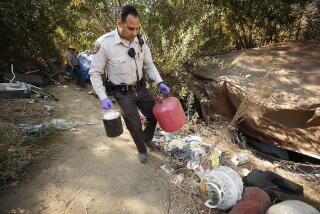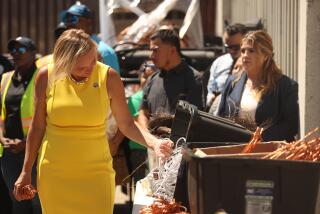Inglewood Alters Plan for Police Property Tax
- Share via
The Inglewood City Council has modified a proposal for a police tax assessment after homeowners complained that the proposal would cost them too much.
After several meetings by council members and residents in past weeks, city officials changed the proposed property tax so that owners of single-family homes would pay less and owners of large apartment buildings, businesses and industrial properties would pay more. A public hearing on the proposal is scheduled June 21 at Inglewood High School.
Increase Street Patrols
Council members Tuesday unanimously approved a resolution declaring intent to establish the police benefit assessment district, which would raise about $1.4 million annually to pay for a 20-officer anti-crime task force. Officials said the task force, which would be created this fall, and a planned redeployment in the department would dramatically increase street patrols.
Inglewood’s crime rate has decreased more than 25% in the past six years, but the city remains plagued by violent crime related to gang and drug activity.
Under the original assessment district proposal presented to the council earlier this month, single-family residences would have paid $60 a year, multiple-unit properties would have paid $90 a year and commercial and industrial owners would have paid $120.
City officials changed the proposal in response to complaints that homeowners would have paid a disproportionate share of the tax, and because apartment buildings and businesses require more police services.
Under the new proposal, the city would charge a single-family property $53 a year. A 15% credit for homeowners who live in their residences would lower the charge to about $45.
The rates for other property would be calculated on a per-unit basis, using a sliding scale formula in which the $53 base rate decreases as the number of residential units increases. The formula corresponds to police statistics showing the demand for police services increases with the number of dwelling units.
A report to the council by Police Chief Raymond Johnson also stated that commercial properties require more police services than single-family homes.
The assessment district would charge about $92 annually for a two-unit property, about $167 for a five-unit property and $2,011 for 150 units.
Condominium Units
Apartment building owners who live on their property will be able to claim a 15% credit for one unit. All condominium units would be assessed a flat rate of $24.26.
Assessments on non-residential property would be calculated according to size of parcel frontage on a sliding scale with the charge per foot decreasing as the frontage increases.
A commercial parcel with a 50-foot frontage, for example, would pay twice the rate for a single-family home, or $106. A commercial property with 400 feet of frontage would pay about $367 annually. The proposed per-linear-foot charge decreases as the frontage increases, with vacant property paying one-third that of developed land.
Only one resident spoke out against the proposal at Tuesday’s council meeting. Council members have said most constituents want more police and are mainly concerned with making sure the assessment is equitable.
The money would pay for hiring and equipping the permanent 20-officer “Crime Suppression Team,” which would target gang and drug activity.
The current 187-member police force would be further augmented by a redeployment recommended in February by Public Administration Services, a consulting firm that recommended hiring five new officers and streamlining investigative and desk jobs to put more police on the street.
The city plans to transfer 14 officers to uniformed duties, increasing the number of patrol cars during peak periods from about eight to as many as 19. This will double the amount of time patrol officers can devote to “directed patrol” of known trouble spots, from 25% to nearly 50%, Johnson’s report said.
More officers will also mean an increase in task force operations such as the department’s highly effective “reverse stings,” in which undercover officers have taken over “rock houses” and arrested scores of unsuspecting buyers.
The impact of task forces was dramatized in 1986, when Inglewood police conducted a 2 1/2-month crackdown on street drug sales with 30 officers. The results: 900 drug related arrests, thousands of dollars in seized drugs and stolen property and, during the 10 weeks, a 36% drop in drug-related robberies and burglaries.
More to Read
Sign up for Essential California
The most important California stories and recommendations in your inbox every morning.
You may occasionally receive promotional content from the Los Angeles Times.












